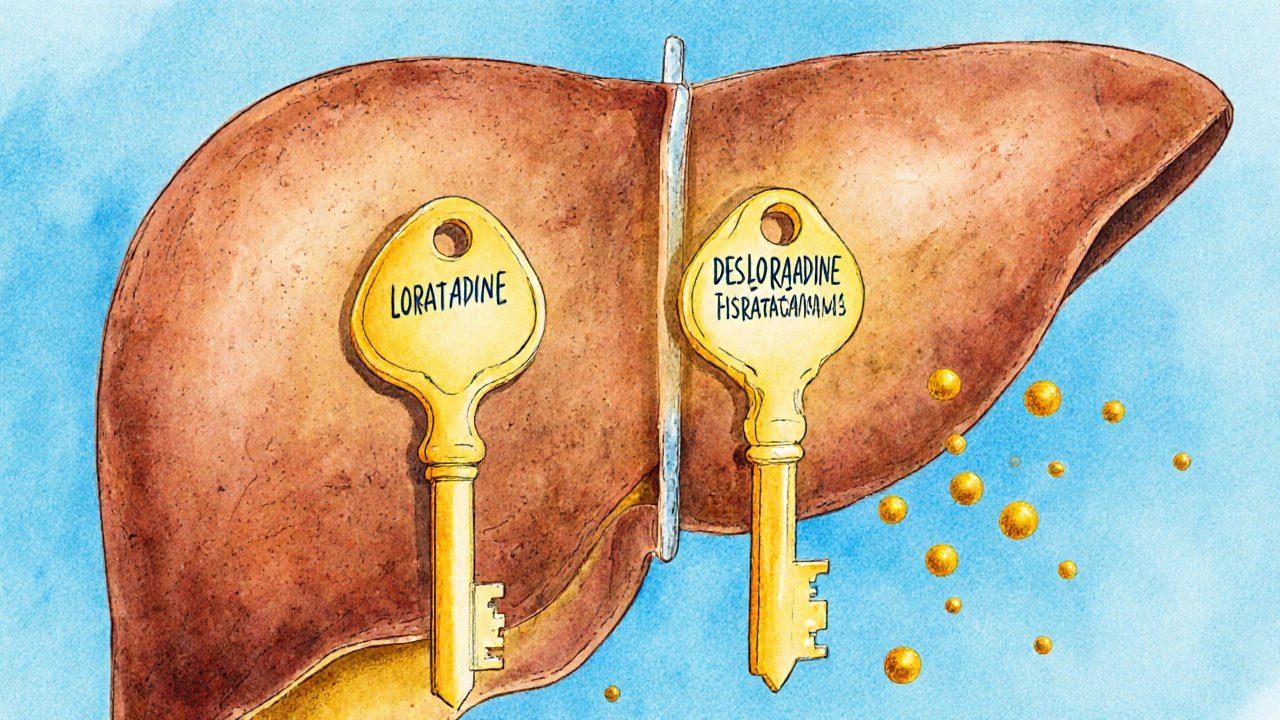Antihistamine Decision Tool
Which Antihistamine is Right for You?
Answer these questions to get a personalized recommendation based on the latest medical evidence comparing desloratadine and loratadine.
Desloratadine vs Loratadine: Which Antihistamine Works Better for Allergies?
If you’ve ever reached for an allergy pill and wondered why there are so many options, you’re not alone. Two of the most common choices are desloratadine and loratadine. Both are second-generation antihistamines, both are non-sedating, and both are sold over the counter in many countries. But they’re not the same. One is the active ingredient your body makes from the other. That small difference changes everything-from how fast it works, to how long it lasts, to how many side effects you might get.
Let’s cut through the noise. This isn’t about brand names or ads. It’s about what actually happens in your body when you take either one. And whether the extra cost of desloratadine is worth it-or if plain old loratadine does just fine.
How They Work: One Is the Other’s Active Ingredient
Loratadine was approved in the 1990s and became a household name. But here’s the twist: your liver turns loratadine into desloratadine. That’s right-desloratadine isn’t just a cousin. It’s the real deal. The version that actually binds to histamine receptors and blocks allergy symptoms.
Think of it like this: loratadine is a key that needs to be cut before it fits the lock. Desloratadine is the already-cut key. It’s more precise, more powerful, and works faster at the cellular level. Studies show desloratadine is significantly more potent than loratadine. It doesn’t just block histamine-it also reduces inflammation by calming down white blood cells, stopping them from releasing chemicals that cause swelling, itching, and congestion.
This extra anti-inflammatory effect matters. For people with moderate to severe allergies, especially those with itchy eyes, nasal congestion, or asthma triggers, desloratadine often delivers noticeably better relief. The European Academy of Allergy and Clinical Immunology gave it a 4.7 out of 5 for effectiveness, compared to 4.2 for loratadine.
Dosing: Same Frequency, Different Strength
Both medications are taken once a day. That’s convenient. But the doses are different.
- Loratadine: 10 mg per day
- Desloratadine: 5 mg per day
Even though desloratadine’s dose is half, it’s not weaker-it’s stronger. Because it’s the active metabolite, you need less of it to get the same-or better-effect. The half-life of desloratadine is 27 hours. Loratadine’s is shorter, around 8 to 10 hours. That means desloratadine stays in your system longer, giving you more consistent 24-hour coverage. If you’ve ever felt your allergy meds wearing off by late afternoon, desloratadine might be why.
Another practical difference: desloratadine is approved for kids as young as 1 year old. Loratadine? Only for kids 2 and up. If you’re treating a toddler with chronic hives or seasonal allergies, that one-year gap matters. Clinical trials show that in children aged 2 to 5, desloratadine reaches steady levels faster and with more predictable results than loratadine.

Side Effects: Less Is More
Both are called non-sedating for a reason. They barely cross the blood-brain barrier, so they don’t make most people drowsy. But that doesn’t mean they’re side effect-free.
Loratadine’s most common side effects are dry mouth, headache, and tiredness-though tiredness happens in less than 10% of users. Desloratadine has similar side effects, but overall, fewer people report them. A large pediatric study showed diarrhea in 6.1% of kids on desloratadine versus 2.4% on placebo. Irritability was slightly higher too, at 6.9% versus 5.6%. But here’s the key: those numbers are still low. And in adults, the difference in side effects is even smaller.
Some users on Drugs.com report headaches with desloratadine that they didn’t get with loratadine. But those are exceptions. Overall, desloratadine is rated 7.2/10 by users, compared to 6.3/10 for loratadine. On Reddit, nearly 70% of users with severe allergies said they switched to desloratadine and noticed better control of eye symptoms and congestion.
One major safety advantage: desloratadine doesn’t affect heart rhythms. It doesn’t lengthen the QTc interval, which reduces the risk of dangerous arrhythmias. That’s important if you’re taking other medications like antibiotics or antidepressants. Loratadine is also safe, but desloratadine’s clean profile makes it a better choice for people on multiple drugs.
Who Gets the Edge? Real-World Use
Let’s talk about real life. In the U.S., loratadine was prescribed over 24 million times in 2023. Desloratadine? Around 9 million. Why? Price. Generic loratadine costs $10-$25 for a 30-day supply. Desloratadine runs $25-$40. For mild allergies, that extra cost may not be worth it.
But if your allergies are worse than a runny nose-think constant congestion, itchy eyes, trouble sleeping, or asthma flare-ups-desloratadine’s stronger anti-inflammatory action makes a difference. The American College of Allergy, Asthma, and Immunology now recommends switching to desloratadine if loratadine doesn’t work after 2-4 weeks.
There’s also a practical group that benefits: people who’ve had bariatric surgery. Desloratadine dissolves completely in the gut after surgery. Loratadine? It doesn’t. That means some patients simply can’t absorb it properly. For them, desloratadine isn’t a preference-it’s a necessity.
What About Newer Options?
You might wonder: aren’t there better antihistamines now? Drugs like cetirizine, fexofenadine, or even nasal sprays? Sure. But desloratadine and loratadine are still first-line choices because they’re safe, effective, and cheap. The World Allergy Organization says they’ll remain staples for years to come.
And while biologics like dupilumab are changing the game for severe eczema or asthma, they’re injectables, expensive, and only for extreme cases. For most people with seasonal or chronic allergies, an oral pill still wins.

When to Choose Which
Here’s the bottom line:
- Choose loratadine if your allergies are mild, you’re on a tight budget, or you’ve used it before without issues.
- Choose desloratadine if you need stronger symptom control, have nasal congestion or itchy eyes that won’t quit, are treating a child under 2, have other medications you’re taking, or had no luck with loratadine after a few weeks.
Neither will make you sleepy. Neither will wreck your liver. Both are safe for long-term use. But desloratadine gives you more power in a smaller pill-with fewer side effects for most people.
Frequently Asked Questions
Can I take desloratadine and loratadine together?
No. Desloratadine is the active form of loratadine. Taking both together won’t give you double the benefit-it just increases your risk of side effects like headache or dry mouth. Stick to one or the other.
Does food affect how these medications work?
No. Neither desloratadine nor loratadine needs to be taken with food. You can take them before breakfast, after dinner, or on an empty stomach. Absorption isn’t affected.
How long does it take for desloratadine to start working?
You’ll usually feel relief within 1 to 3 hours after taking desloratadine. Loratadine kicks in a bit faster-within 1 to 1.5 hours-but desloratadine lasts longer and provides more consistent coverage throughout the day.
Is desloratadine safe during pregnancy?
Both desloratadine and loratadine are classified as Category B in pregnancy, meaning animal studies show no risk and human data doesn’t suggest harm. But always check with your doctor before taking any medication while pregnant.
Can I switch from loratadine to desloratadine right away?
Yes. You can switch directly from 10 mg of loratadine to 5 mg of desloratadine. There’s no need to taper. Many people notice improved symptom control within a few days.
Do these medications cause weight gain?
Neither desloratadine nor loratadine is linked to weight gain. Unlike some older antihistamines, they don’t affect appetite or metabolism. Weight changes are more likely due to other factors like reduced activity from allergies or steroid use.
Final Thoughts
Desloratadine isn’t just a fancier version of loratadine. It’s the upgraded engine inside the same car. If you’ve been stuck with mild relief from loratadine, switching might be the change you’ve been waiting for. But if your allergies are under control and you’re saving money, there’s no reason to switch.
The best choice isn’t about what’s newer or pricier. It’s about what works for your body-and your budget.

Andy Slack
November 6, 2025 AT 19:08Rashmi Mohapatra
November 7, 2025 AT 09:07Abigail Chrisma
November 8, 2025 AT 05:02Ankit Yadav
November 9, 2025 AT 07:09Meghan Rose
November 10, 2025 AT 02:19Steve Phillips
November 11, 2025 AT 13:32Rachel Puno
November 12, 2025 AT 20:54Clyde Verdin Jr
November 14, 2025 AT 05:39Key Davis
November 14, 2025 AT 12:21Cris Ceceris
November 16, 2025 AT 01:04Brad Seymour
November 17, 2025 AT 06:47